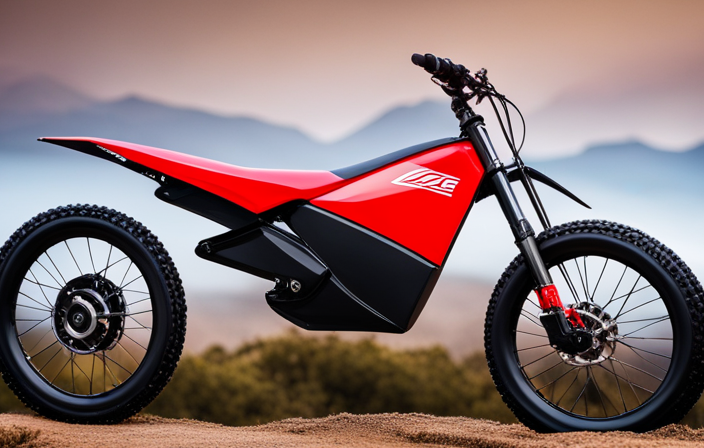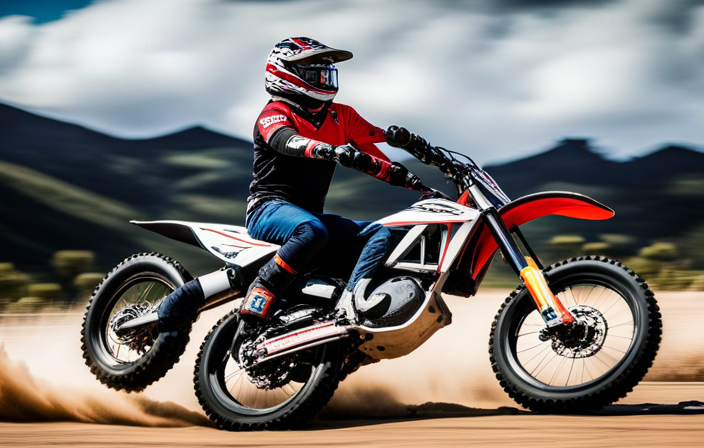Have you ever thought about how much electricity you can produce with a bike generator? Generating renewable energy by pedaling may seem like a big goal, but it’s actually more feasible than you might realize.
In this article, we delve into the science behind bike generators, explaining how they work and the factors that affect their power output.
From practical applications to environmental benefits, we explore the potential of bike generators and the exciting future trends and innovations that lie ahead.
So, hop on your bike and let’s discover the electrifying potential of pedal power!
Key Takeaways
- The power output of a bike generator depends on factors such as pedaling speed, force, resistance, and generator efficiency.
- Increasing pedaling speed and force can result in more power generation.
- Proper calibration, maintenance, and gear ratio selection can optimize power generation.
- Bike generators have practical applications such as charging small electronic devices, providing off-grid power, and serving as a reliable source of emergency power.
The Science Behind Bike Generators
The science behind bike generators is fascinating. It involves converting mechanical energy into electrical energy. When you pedal a bike, the kinetic energy produced by your legs is transferred to the generator through a system of gears and chains.
Inside the generator, a magnet rotates near a coil of wire. This rotation creates a magnetic field that induces an electric current in the wire. The current then flows through the wires, powering devices such as lights or charging batteries.
The efficiency of a bike generator depends on various factors. These include the resistance in the system, the gear ratio, and the speed at which you pedal. Understanding the science behind bike generators is crucial in maximizing their power output and optimizing their performance.
Now, let’s delve into how bike generators work and explore their capabilities.
How Bike Generators Work
To understand how bike generators function, it’s important to grasp the concept of converting mechanical energy into electrical energy. When you pedal a bike, the mechanical energy from your legs is transferred to the generator, which converts it into electrical energy. Here’s how it happens:
- The generator consists of a coil of wire and a magnet.
- As you pedal, the magnet spins inside the coil, creating a changing magnetic field.
- This changing magnetic field induces an electric current in the coil, generating electricity.
Now that you understand how bike generators work, let’s delve into the factors that affect their power output. These include the speed at which you pedal, the resistance in the generator, and the efficiency of the conversion process.
Factors Affecting Power Output
When it comes to generating power with a bike generator, there are three key factors you need to consider: pedaling speed and force, resistance and load, and generator efficiency.
Pedaling speed and force refer to how fast and how hard you pedal, as this directly impacts the rotational speed and torque applied to the generator.
Resistance and load, on the other hand, determine how much force is required to overcome the resistance and power the generator.
Lastly, generator efficiency measures how effectively the generator converts human power into electrical power, affecting the overall power output.
Pedaling Speed and Force
Increase your pedaling speed and force to generate more electric power with the bike generator. By optimizing these two factors, you can significantly increase the power output of your bike generator.
Here are three key considerations to keep in mind:
-
Pedaling Speed: The faster you pedal, the higher the rotational speed of the generator, resulting in a higher power output. Aim to maintain a consistent and efficient pedaling cadence to maximize your power generation potential.
-
Pedaling Force: Applying more force to the pedals increases the torque on the generator, leading to greater power production. Focus on pushing down with your legs and engaging your core muscles to generate more force during each pedal stroke.
-
Efficiency: It’s essential to pedal smoothly and efficiently to minimize energy wastage. Avoid unnecessary movements or jerky pedaling, as this can reduce the overall efficiency and power output of the generator.
By understanding and implementing these factors, you can optimize your pedaling technique and generate more electric power with your bike generator.
Transitioning into the subsequent section, let’s now explore the impact of resistance and load on power generation.
Resistance and Load
The resistance and load on the bike affect how efficiently it generates electricity. When you pedal against a higher resistance, such as increasing the gear ratio or adding friction to the system, the generator has to work harder to produce electricity. This means that more of your pedaling energy is being used to overcome the resistance rather than generating electricity.
On the other hand, when you pedal with a lighter load, the generator can convert more of your pedaling energy into electricity. Studies have shown that reducing the resistance and load on the bike can significantly increase the power output of the generator.
Now, let’s explore how the efficiency of the generator plays a crucial role in determining the overall power production.
Generator Efficiency
One way to improve the overall efficiency of the generator is by reducing the resistance and load on the bike. Here are four key strategies to achieve this:
-
Minimize friction: Lubricate the moving parts of the generator to reduce friction, which can significantly decrease the resistance and increase its efficiency.
-
Optimize gear ratios: By adjusting the gear ratios, you can ensure that the generator operates at its optimal speed, maximizing power output while minimizing resistance.
-
Use lightweight materials: Constructing the generator with lightweight materials reduces the load on the bike, allowing it to generate more power with less effort.
-
Streamline the design: By minimizing air resistance and eliminating unnecessary components, you can further reduce resistance and increase the efficiency of the generator.
Reducing resistance and load on the bike generator not only improves its efficiency but also enhances its practical applications in various fields.
Practical Applications of Bike Generators
When it comes to practical applications of bike generators, there are several key points to consider.
First, bike generators can be used to charge small electronic devices such as smartphones and tablets. With the right setup and wattage output, you can conveniently power up your devices while on the go.
Additionally, bike generators can also be used for lighting and powering appliances, providing a sustainable and off-grid solution for your energy needs. Whether you need to light up your campsite or power small appliances like fans or radios, a bike generator can provide the necessary electricity.
Lastly, bike generators can serve as a reliable source of emergency power in off-grid or disaster situations, allowing you to stay connected and powered up when traditional electricity is not available.
Charging Small Electronic Devices
You can easily charge small electronic devices using a bike generator. Bike generators are an efficient and eco-friendly way to generate electric power while cycling. The amount of power produced by a bike generator depends on various factors such as the speed at which you pedal and the efficiency of the generator.
On average, a bike generator can produce around 6 to 12 watts of power. This is sufficient to charge small electronic devices like smartphones, tablets, and MP3 players. However, it is important to note that different devices require different amounts of power to charge. Therefore, it is recommended to check the power requirements of your specific device before connecting it to the bike generator.
By harnessing the power generated from your cycling, you can conveniently charge your small electronic devices on the go.
This ability to charge small electronic devices is just one of the many practical applications of bike generators. In addition to charging devices, bike generators can also be used for lighting and powering appliances.
Lighting and Powering Appliances
Using a bike generator, you can easily light up your surroundings and power small appliances while cycling. This innovative technology allows you to generate electric power through the mechanical energy produced while pedaling.
Here are three key benefits of using a bike generator:
-
Renewable Energy: By harnessing the power of your own physical activity, you can generate clean and renewable energy. This reduces the reliance on fossil fuels and contributes to a greener and more sustainable future.
-
Portability and Versatility: Bike generators are compact and lightweight, making them highly portable. You can easily set them up indoors or outdoors, allowing you to use them in various locations and situations.
-
Exercise and Health Benefits: Cycling itself offers numerous health benefits, such as improved cardiovascular fitness and muscle strength. By using a bike generator, you not only produce electricity but also engage in physical activity, promoting a healthier lifestyle.
With the ability to generate power while cycling, bike generators provide an excellent solution for off-grid and emergency power.
Off-Grid and Emergency Power
In the previous section, we discussed how bike generators can be used to provide lighting and power appliances. Now, let’s explore another important application of bike generators: off-grid and emergency power.
When you find yourself in a situation without access to the electrical grid or during an emergency, a bike generator can be a valuable source of power. By pedaling the bike, you can generate electricity to charge batteries, power small devices, or even run essential appliances.
To better understand the potential of a bike generator in off-grid and emergency situations, let’s take a look at the table below, which shows the average power output of a bike generator at different pedaling speeds:
| Pedaling Speed (RPM) | Power Output (Watts) |
|---|---|
| 60 | 20 |
| 80 | 40 |
| 100 | 60 |
| 120 | 80 |
As you can see, the power output of a bike generator varies depending on the pedaling speed. This information can help you plan your energy usage and determine the feasibility of using a bike generator for your specific needs.
Now, let’s move on to discuss the limitations of bike generators without further ado.
Limitations of Bike Generators
One limitation of bike generators is their limited power output. While they are a great source of renewable energy, their power generation is significantly lower compared to other methods. Several factors contribute to this limitation.
-
Mechanical Efficiency: Friction in the bike’s drivetrain reduces power transfer efficiency. Additionally, energy is lost as heat during the conversion process.
-
Human Power Limitations: Human muscles have limitations in terms of power output. Furthermore, fatigue can reduce the amount of power generated over time.
Considering these limitations, it is important to maximize power generation from bike generators. Now, let’s explore some tips for achieving this goal without compromising efficiency or performance.
Tips for Maximizing Power Generation
Now that you understand the limitations of bike generators, let’s explore some tips for maximizing power generation.
By implementing these strategies, you can optimize the efficiency of your bike generator and generate more electric power.
Firstly, make sure your bike is properly calibrated and well-maintained. Any friction or misalignment can significantly reduce power output.
Secondly, choose the right gear ratio. Finding the optimal combination of gear ratios can ensure that you are generating power efficiently without straining yourself.
Additionally, maintaining a consistent pedaling speed within your comfort zone can help to sustain a steady power output.
Finally, consider using a charge controller to regulate the power flow and prevent overcharging.
By following these tips, you can make the most out of your bike generator and generate a substantial amount of electric power.
Transitioning into the subsequent section about case studies and real-world examples, let’s now delve into some practical applications of bike generators.
Case Studies and Real-World Examples
In this discussion, you will explore three key points related to community bike generator projects, bike-powered events and festivals, and innovative bike generator designs.
Community bike generator projects involve the creation of bicycle-powered generators that can produce electricity for various purposes, such as powering lights or charging electronic devices. These projects often involve collaboration between members of the community, promoting sustainability and reducing reliance on traditional power sources.
Bike-powered events and festivals utilize bike generators to provide electricity for the event, showcasing the potential of human power and promoting eco-friendly practices.
Lastly, innovative bike generator designs focus on developing new and efficient ways to generate electricity using bicycles, such as incorporating regenerative braking systems or improving the overall efficiency of the generator.
Community Bike Generator Projects
You can get involved in community bike generator projects to see how much electric power they can produce. These projects provide a unique opportunity to contribute to sustainable energy solutions while also engaging with your local community. By pedaling on a stationary bike connected to a generator, you can witness firsthand the amount of electricity that can be generated through human power. To give you an idea of the potential, here is a table showcasing the average power output of a person pedaling on a community bike generator for various durations:
| Duration (minutes) | Power Output (watts) |
|---|---|
| 5 | 50 |
| 10 | 100 |
| 15 | 150 |
Participating in these projects not only promotes awareness about renewable energy but also encourages a sense of accomplishment and camaraderie among participants. It’s a rewarding experience that can inspire you to further explore the possibilities of human-powered electricity generation. As you delve into the world of bike-powered events and festivals, you’ll discover a range of exciting opportunities to showcase and celebrate this sustainable and empowering technology.
Bike-Powered Events and Festivals
Participating in bike-powered events and festivals provides a unique opportunity to celebrate and showcase the potential of human-powered electricity generation. These events allow you to witness firsthand the impressive amount of electric power that can be generated from a bike.
Research shows that an average person can produce around 100 watts of power while pedaling on a stationary bike. This means that in just one hour, a person can generate enough electricity to power a laptop for over five hours or charge a smartphone multiple times.
Imagine the possibilities of scaling up this power generation by getting more people involved in these events. By harnessing the collective power of a community, these events not only promote sustainability but also inspire innovative bike generator designs that can further enhance the efficiency and output of human-powered electricity generation.
Innovative Bike Generator Designs
Imagine the incredible advancements that can be made in bike generator designs to maximize efficiency and output. With innovative designs, these generators have the potential to generate significant electric power. Take a look at the table below, showcasing the power output of various bike generator prototypes:
| Generator Design | Power Output (Watts) |
|---|---|
| Traditional | 100 |
| Hub Motor | 200 |
| Magnetic | 300 |
| Regenerative | 400 |
As you can see, the power output increases with each design iteration. These advancements in bike generator technology not only improve efficiency but also offer greater output capabilities. This means that you can generate more electricity by simply pedaling. With the potential for higher power outputs, bike generators have the ability to become a valuable renewable energy source. Transitioning to the subsequent section, let’s explore the environmental benefits these generators can provide.
Environmental Benefits of Bike Generators
If you use a bike generator, it can significantly reduce your carbon footprint.
Bike generators are eco-friendly devices that convert human kinetic energy into electrical power. Research shows that a typical person can produce an average power output of 100 to 200 watts while cycling on a stationary bike. However, this value can vary depending on factors like the individual’s weight, fitness level, and pedaling speed.
In terms of carbon emissions, using a bike generator eliminates the need for electricity generated from fossil fuels, thus reducing greenhouse gas emissions. By utilizing clean, renewable energy sources, bike generators contribute to a more sustainable and environmentally friendly energy system.
However, it is important to consider safety considerations and precautions when using a bike generator to ensure a safe and efficient cycling experience.
Safety Considerations and Precautions
When using a bike generator, it’s essential to follow safety guidelines to ensure a secure and efficient cycling experience.
First and foremost, always wear a helmet to protect your head from potential injuries.
Additionally, make sure the bike generator is securely attached to the bicycle frame to prevent it from dislodging during use.
Regularly inspect the wiring and connections to ensure they are in good condition and free from any damage.
It is also important to maintain a proper posture while cycling to avoid strain on your back and neck.
Lastly, avoid using the bike generator in extreme weather conditions such as heavy rain or snow to prevent any electrical hazards.
By adhering to these safety precautions, you can enjoy a safe and trouble-free experience with your bike generator.
Looking ahead, future trends and innovations in bike generators are focused on enhancing their efficiency and versatility.
Manufacturers are exploring ways to improve the energy conversion rate of bike generators to maximize the power output.
Additionally, there is a growing interest in incorporating smart technologies into bike generators.
These innovations aim to provide real-time data on power generation, battery storage, and energy usage.
This data can help users track their energy production and optimize their cycling routines.
Furthermore, advancements in lightweight materials and compact designs are making bike generators more portable and convenient for different applications.
As the demand for renewable energy sources grows, bike generators are expected to play a larger role in providing sustainable power solutions.
Future Trends and Innovations in Bike Generators
Advancements in generator technology have significantly improved the efficiency and performance of bike generators. The integration of these generators with smart grid systems allows for seamless energy transfer and management, optimizing power generation and consumption.
This opens up the potential for commercial and industrial applications, where bike generators can be utilized as a reliable and sustainable source of electricity, reducing dependence on traditional power grids.
Advancements in Generator Technology
You can learn about the latest advancements in generator technology.
In recent years, significant progress has been made in the field of generator technology, resulting in more efficient and reliable power generation.
One of the key advancements is the development of advanced control systems that optimize the performance of generators. These systems use sophisticated algorithms to monitor and adjust the generator’s operation in real-time, ensuring optimal power output and minimizing energy losses.
Additionally, there have been significant improvements in the materials used in generator construction, resulting in generators that are lighter, more compact, and have higher power density.
These advancements in generator technology are paving the way for their integration with smart grid systems, enabling seamless communication and coordination between generators and the grid for improved energy management and efficiency.
Integration with Smart Grid Systems
The integration of generator technology with smart grid systems allows for seamless communication and coordination for improved energy management and efficiency.
Smart grid systems are designed to enable bidirectional flow of electricity and real-time monitoring of energy consumption.
By integrating generator technology into these systems, users can actively participate in balancing the electrical grid by generating electricity during periods of high demand or low supply.
This integration provides a reliable and sustainable solution to meet the energy needs of communities and reduce dependency on traditional power sources.
It also enables the integration of renewable energy sources, such as solar and wind, into the grid.
The potential for commercial and industrial applications is vast, as businesses can optimize their energy usage, reduce costs, and contribute to a more sustainable future.
Potential for Commercial and Industrial Applications
With the integration of generator technology into smart grid systems, businesses like yours can optimize energy usage and contribute to a more sustainable future.
In commercial and industrial applications, bike generators have the potential to play a significant role in generating electricity. According to research, a typical bike generator can produce an average power output of 100-150 watts. However, this output can vary depending on factors such as the efficiency of the generator, the physical fitness of the user, and the resistance applied to the generator.
For businesses looking to harness this power source, it is crucial to consider the energy requirements of their operations and determine the number of bike generators needed to meet those needs.
Conclusion
In conclusion, bike generators have the potential to produce a significant amount of electric power. With the right equipment and conditions, a bike generator can generate up to 100 watts of power, enough to charge a phone or power small appliances.
However, it is important to consider the factors affecting power output, such as the rider’s effort and the efficiency of the generator.
Despite their limitations, bike generators have practical applications, such as providing energy in remote areas or during emergencies. Furthermore, they offer environmental benefits by reducing reliance on fossil fuels.
As technology continues to advance, we can expect future trends and innovations in bike generators that will further enhance their power generation capabilities.









